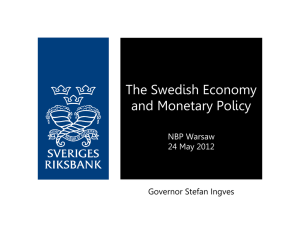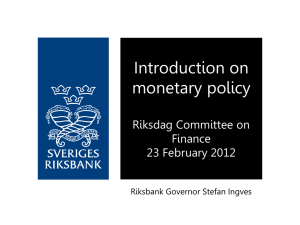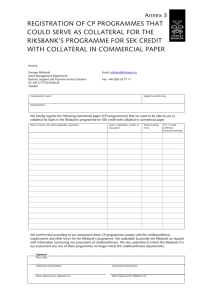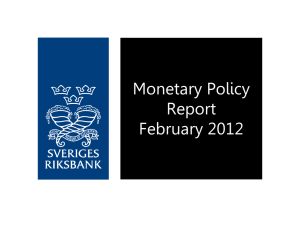Lower repo rate…
advertisement
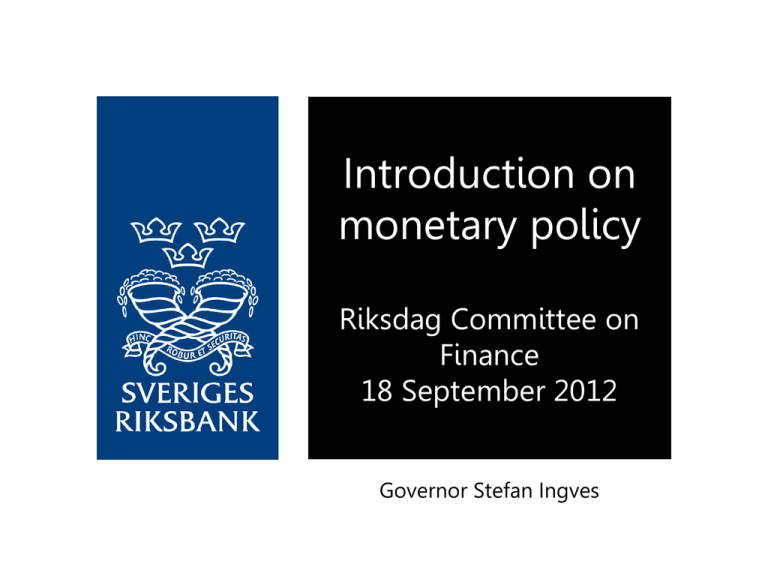
Introduction on monetary policy Riksdag Committee on Finance 18 September 2012 Governor Stefan Ingves Perspectives on monetary policy Sweden’s economy has coped well throughout the financial and debt crises The inflation target has served as a foundation for monetary policy A lowered interest rate counteracts low inflation and supports economic activity Sweden has coped well in a turbulent international situation The financial crisis – dramatic fall in GDP, followed by strong recovery in Sweden GDP level 108 108 USA Euro area Sweden 104 104 100 100 96 96 92 92 07 08 Note. Index, 2007 Q4=100. 09 10 11 12 Sources: The OECD, Statistics Sweden and the Riksbank From financial crisis to debt crisis in Europe Sovereign debts in various countries 180 180 Grekland Irland Italien Portugal Spanien Sverige 160 140 160 140 120 120 100 100 80 80 60 60 40 40 20 20 0 0 90 92 94 96 98 00 02 Note. Public gross debt as a percentage of GDP Broken lines represent the IMF’s forecast. 04 06 08 10 12 14 Source: IMF Improvements from the 1990s in Sweden Strong growth in productivity Reform of fiscal and monetary policy Stable public finances Low and stable inflation Sweden’s economy is holding up well Strong GDP growth GDP growth 2010 and 2011 in various regions and countries 10 10 2010 9 9 2011 8 8 7 7 6 6 5 5 4 4 3 3 2 2 1 1 0 0 Euro area Note. Annual percentage change. USA Sweden BRIC Sources: Bureau of Economic Analysis, Eurostat, IMF and Statistics Sweden Large current account surplus in Sweden Current account balance 2011 8 8 6 6 4 4 2 2 0 0 -2 -2 -4 -4 -6 -6 -8 -8 -10 -10 Note. Percentage of GDP Source: IMF Resilient Swedish labour market Unemployment, per cent 12 12 Sweden Euro area 10 10 USA 8 8 6 6 4 4 2 2 0 0 00 01 02 03 04 05 06 07 08 09 10 11 12 Sources: Bureau of Labor Statistics, Eurostat and Statistics Sweden Low loan losses in Swedish banks 120 120 Profit before loan losses Loan losses 100 100 80 80 60 60 40 40 20 20 0 0 -20 -20 90 92 94 96 98 00 02 04 06 08 Note. Summed up over four quarters, SEK billion, fixed prices, March 2012. Broken lines refer to the Riksbank’s forecast in Financial Stability Report 2012:1. 10 12 14 Sources: Bank reports and the Riksbank Recent appreciation of the krona Trade-weighted exchange rate, TCW index 160 160 150 150 140 140 130 130 120 120 110 110 100 100 90 90 80 80 70 70 60 60 80 82 84 86 88 90 Note. Index, 18 Nov 1992 = 100 92 94 96 98 00 02 04 06 08 10 12 Source: The Riksbank Perspectives on monetary policy and the inflation target Lower and more stable inflation Inflation in Sweden 1970-2012 16 16 CPI 14 14 Average 1995-2011 12 12 10 10 8 8 6 6 4 4 2 2 0 0 -2 -2 70 75 80 85 Note. Annual percentage change of the CPI 90 95 00 05 10 Source: Statistics Sweden The inflation target and inflation in figures January 1993: Inflation should be 2 per cent as of 1995, measured in terms of the CPI CPI inflation 1995-2011: 1.5 per cent* CPIF inflation 1995-2011: 1.8 per cent* Over half of the deviation from 2 per cent in CPI inflation can be explained by a falling interest rate trend *Measured using ’real-time data’, that is without reference to the change in calculation method introduced in 2005 Confidence in the inflation target Actual and expected inflation, per cent 5 Inflation expectations 5 CPI 4 4 3 3 2 2 1 1 0 0 -1 -1 -2 -2 94 96 98 00 02 04 06 Note. Inflation measured by CPI. Expectations refer to money market agents. 08 10 12 14 16 Sources: Prospera Research and Statistics Sweden Unemployment reflects structural problems Unemployment and output gap, per cent 12 12 Output gap 10 10 Unemployment 8 8 Unempoyment, average 6 6 4 4 2 2 0 0 -2 -2 -4 -4 -6 -6 -8 -8 80 82 84 86 88 90 92 94 96 98 00 02 Note. Output gap according to the production function approach. 04 06 08 10 12 Sources: Statistics Sweden and the Riksbank The financial crisis a reminder of the risks on the housing and credit markets Real housing prices in various countries 300 300 Ireland 250 250 Spain USA 200 200 150 150 100 100 50 50 0 0 80 82 84 86 Note. Index, 1996 Q1=100. 88 90 92 94 96 98 00 02 04 06 08 10 12 Source: Reuters EcoWin The Riksbank has warned of the risks in the Swedish housing market Real housing prices in various countries 300 300 Sweden Ireland 250 250 Spain USA Germany 200 200 150 150 100 100 50 50 0 0 80 82 84 86 Note. Index, 1996 Q1=100. 88 90 92 94 96 98 00 02 04 06 08 10 12 Source: Reuters EcoWin Household debt must be monitored carefully Household debt and post-tax interest expenditure, per cent of disposable income 220 22 200 20 180 18 160 16 140 14 120 12 100 10 80 8 60 6 40 4 20 2 0 0 93 95 97 99 01 03 Debt ratio (left scale) 05 07 09 11 13 15 Interest ratio (right scale) Note. Broken lines refer to the Riksbank’s forecast in Financial Stability Report 2012:1. Sources: Statistics Sweden and the Riksbank Risks must be taken into account Risks on the credit and housing markets must be taken into account in monetary policy Other measures: macroprudential policy instruments, amortisation requirements, increased housing supply… But few of these are in place at present The principle of prudence has been successful Current monetary policy A lowered interest rate counteracts low inflation and supports economic activity Weak developments in euro area GDP, annual percentage change 6 6 4 4 2 2 0 0 -2 -2 The world -4 -4 USA Euro area -6 -6 00 02 04 06 08 10 12 14 Sources: Bureau of Economic Analysis, Eurostat and the Riksbank Growth will slow down in the period ahead GDP, quarterly changes in per cent calculated as an annual rate, seasonally-adjusted data 12 12 8 8 4 4 0 0 -4 -4 -8 -8 July -12 September -16 -12 -16 07 09 11 13 15 Sources: Statistics Sweden and the Riksbank Stronger krona Competition-weighted nominal exchange rate 160 160 July September 150 150 140 140 130 130 120 120 110 110 07 09 Note. TCW, Index, 18 Nov 1992 = 100 11 13 15 Source: The Riksbank Labour market hindered by weak growth Unemployment 9 9 July September 8 8 7 7 6 6 5 5 07 09 11 13 Note. Per cent of labour force, ages 15-74, quarterly data, seasonallyadjusted 15 Sources: Statistics Sweden and the Riksbank Lower inflationary pressures Weaker growth in the period ahead Positive development of productivity Stronger krona Lower repo rate… 5 5 July September 4 4 3 3 2 2 1 1 0 0 07 08 09 Note. Per cent, quarterly averages 10 11 12 13 14 15 Source: The Riksbank …counteracts excessively low inflation Inflation measured in terms of the CPI and the CPIF 5 5 CPIF 4 4 CPI 3 3 2 2 1 1 0 0 -1 -1 -2 -2 07 09 11 13 Note. Annual percentage change. The CPIF is the CPI with a fixed mortgage rate 15 Sources: Statistics Sweden and the Riksbank Household sector borrowing is increasing at a slower rate Lending to households and companies 20 20 Companies Households 15 15 10 10 5 5 0 0 -5 -5 -10 -10 99 01 03 Note. Annual percentage change. 05 07 09 11 Source: Statistics Sweden A forecast, not a promise The repo rate 7 7 90% 75% 50% Outcome Forecast 6 5 6 5 4 4 3 3 2 2 1 1 0 0 -1 -1 07 09 Note. Per cent, quarterly averages 11 13 15 Source: The Riksbank Sweden’s economy has coped well throughout the financial and debt crises The inflation target has served as a foundation for monetary policy A lowered interest rate counteracts low inflation and supports economic activity
